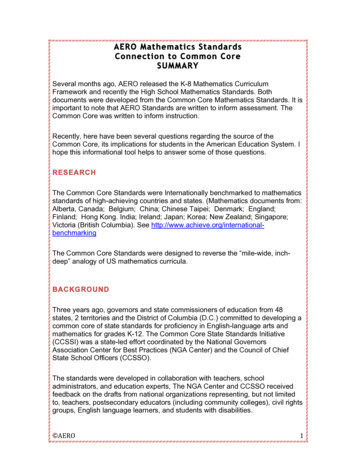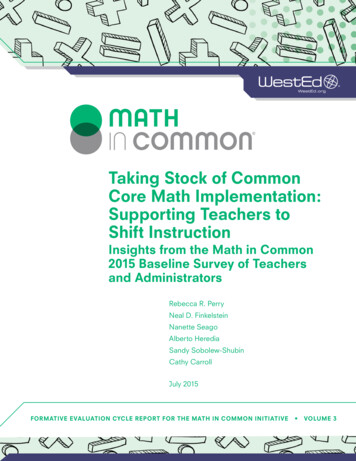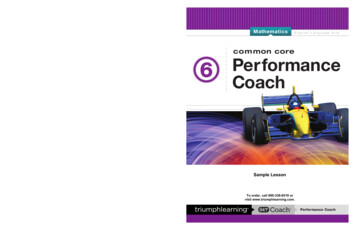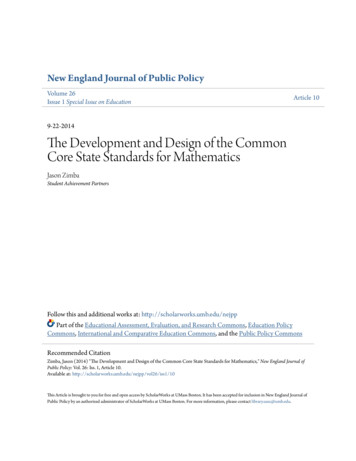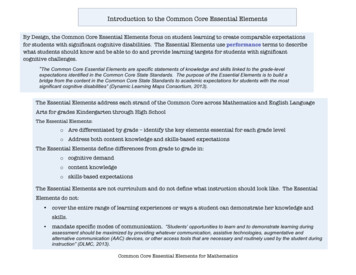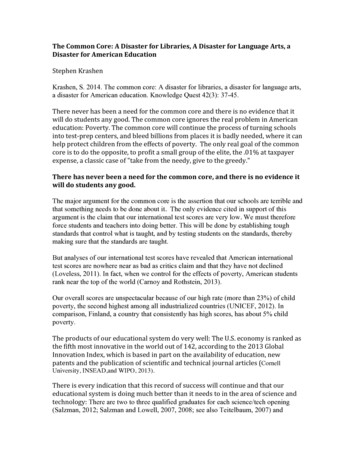
Transcription
shenKrashen, S. 2014. The common core: A disaster for libraries, a disaster for language arts,a disaster for American education. Knowledge Quest 42(3): hoolsintotest- ,andthereisnoevidenceitwilldostudentsanygood.The major argument for the common core is the assertion that our schools are terrible andthat something needs to be done about it. The only evidence cited in support of thisargument is the claim that our international test scores are very low. We must thereforeforce students and teachers into doing better. This will be done by establishing toughstandards that control what is taught, and by testing students on the standards, therebymaking sure that the standards are taught.But analyses of our international test scores have revealed that American internationaltest scores are nowhere near as bad as critics claim and that they have not declined(Loveless, 2011). In fact, when we control for the effects of poverty, American studentsrank near the top of the world (Carnoy and Rothstein, 2013).Our overall scores are unspectacular because of our high rate (more than 23%) of childpoverty, the second highest among all industrialized countries (UNICEF, 2012). Incomparison, Finland, a country that consistently has high scores, has about 5% dtechnicaljournalarticles(CornellUniversity, INSEAD, and WIPO, y:There are two to three qualified graduates for each science/tech opening(Salzman, 2012; Salzman and Lowell, 2007, 2008; see also Teitelbaum, 2007) and
according is no evidence that having national standards and increasing testing haveimproved student learning in the past (Nichols, Glass and Berliner, 2006; Tienken, iddle,2001;DuncanandBrooks- ‐Gunn,2001).Studies have documented how poverty impacts school performance: "Food insecurity,"lack of health care, and lack of access to books, among other aspects of poverty, all havedevastating effects on student's ability to learn.Food insecurityChildren of poverty are likely to suffer from "food insecurity." Studies (Coles 2008/2009)show that food insecure children more likely to have slow language development,problems in social behavior and emotional control. They are more likely to miss schooldays, repeat a grade, and have academic problems.The effects of food insecurity are reversible: When previously food secure childrenexperience food insecurity, their reading development slows down relative to food securechildren. But "a change from food insecurity to food security can bring concomitantimprovements: the study also found that poor reading performance for food insecurechildren in the beginning grades was reversed if the household became food secure by3rd grade" (Coles, 2008/2009).Lack of health careHigh-poverty families are more likely to lack medical insurance or have high copayments, which results in less medical care, and more childhood illness andabsenteeism, which of course negatively impacts school achievement. Berliner (2009)cites studies showing that "children in poor families in most states are six times morelikely to be in less than optimal health, experiencing a wide variety of illnesses andinjuries, as compared with children in higher income families" (p. 16). School is nothelping: Poor schools are more likely to have no school nurse or have a high ratio ofnurses to students (Berliner, 2009).Lack of access to booksThere is very clear evidence that children from high-poverty families have very littleaccess to books at home, at school, and in their communities (Newman and Celano, 2001;
Duke, 2001; additional studies reviewed in Krashen, 2004). Studies also show whenchildren have access to interesting and comprehensible reading material, they read(Krashen, 2001; 2004). And finally, when children read, they improve in all aspects ofliteracy, including vocabulary, grammar, spelling, reading and writing ability(McQuillan, 1998; Krashen, 2004). In fact, the evidence is strong that reading forpleasure, self-selected reading, is the major cause of advanced literacy development.Making sure that all children have access to books makes literacy development possible.Without it, literacy development is impossible.LibrariesLibraries are often the only source of books and other reading material for children ofpoverty and they are a potent source: A number of studies confirm that providing accessto books via libraries has a positive impact on reading development: The better the library(more books, presence of a credentialed librarian, better staffing), the higher the readingscores (e.g.Lance, 2004, no date; Krashen, 2011). Multivariate studies show that thepositive impact of libraries can be as strong as the negative impact of poverty on readingachievement (Achterman, 2008; Krashen, Lee and McQuillan, 2012): In other words, agood library can offset the effect of poverty on literacy development.Protect children from the effect of povertyThe implications are straight-forward: Until poverty is eliminated, until we have fullemployment at a living wage, we need to protect children from the effects of poverty.This means adequate food programs, improved health care, including providing moreschool nurses in high poverty schools, and, of course, more investment in libraries andlibrarians.As readers of this journal know, library funding is not being increased: It is being cut(Kelley, 2010).FundingThere is an obvious source of funding to support food programs, increased health careand libraries and librarians: Reduce testing. An unprecented amount of testing has beenplaned to enforce the standards, far more than the amount done under No Child LeftBehind and far more testing than has ever been seen on this planet (Krashen, 2012). Thenew tests will include the usual end of year tests, but in more subjects, and in more gradelevels, as well as interim tests during the year and possibly pretests in the fall to measureimprovement over the academic year.All tests are to be delivered online. This means that all students must be connected to theinternet, with up-to-date equipment. This will involve a staggering expense, and one thatpromises to increase as systems require updating, replacement, and even completeoverhauls as progress is made in technology (Krashen and Ohanian, 2011), despite thefact that there is no evidence that standards will help, that new tests will help, or thatonline technology will help.
What is clear is that the testing and computer industry will profit, and taxpayers will paythe cost of setting up the infrastructure and the numerous adjustments and changes, assoftware and hardware regularly become obsolete.(I need to point out that I am not presenting an argument against all standardized testing.My position is that we should only have standardized tests that actually do some good,that help with teaching and learning (Krashen, 2008). My position is No UnnecessaryTesting (NUT).)The Nature of the StandardsDespite the claim that the standards do not tell teachers how to teach, the nature of thelanguage arts standards (especially Reading: Foundational Skills, Writing, and Language)make it hard for teachers to do anything but direct instruction.First, the standards have accepted in full the conclusions of the National Reading Panel:“Materials that are aligned to the standards should provide explicit and systematicinstruction and diagnostic support in concepts of print, phonological awareness, phonics,vocabulary development, and fluency,” Coleman and Pimental, K-2 (page 2), as well astext structure (Standards p, 11, 42) and grammar (Appendix A, p. 31, 33). The languagearts standards creators appear to be unaware of the extensive and deep criticism of theNational Reading Panel's conclusions, and the unimpressive results of Reading First,which was based on the these conclusions (Garan, 2002; Krashen, 2001b; 2005; 2009;Allington, 2002; Coles, 2003).Second, the common core standards are so demanding that there will be little time foranything not directly linked to the standards in English language arts classes. Nor shouldthere be, according to the Publisher’s Criteria: “By underscoring what matters most in thestandards, the criteria illustrate what shifts must take place in the next generation ofcurricula, including paring away elements that distract or are at odds with the CommonCore State Standards.” (Coleman and Pimental, Publishers, Criteria, 3-12, page 1). AsAshley Hastings has pointed out, the common core is clearly more than a “core”: it is theentire apple.Third, constant high-stakes testing insures direct teaching. As noted above, the standardswill be enforced by a massive amount of testing, including “interim” testing through theacademic year, to make sure students stay on their “educational trajectory.” (Arne USSecretary of Education Arne Duncan's terminology.) Performance on these tests will haveserious consequences for students, for teachers, and, we are told, even for schools ofeducation: “We need comprehensive data systems that do three things, track studentsthroughout their educational trajectory, track students back to teachers.track teachersback to their schools of education.” (Duncan, 2009). The pressure to stick with what is inthe standards will be extreme, and the force of constant testing will ensure that directteaching methods will be used; educators will be concerned that there is no time for thetarget structures to emerge naturally; it may not happen in time for the next test.In short, it is likely that language arts will consist entirely of direct instruction, with no
time for self-selected reading. (1) This is in conflict with the massive research that showsdirect teaching of aspects of literacy produces very limited results and that most of ourliteracy and academic language competence is the result of reading, especially selfselected reading.The common core and self-selected free readingThe common core disparages self-selected free reading. This quote from the commoncore presents its position on free reading:“Students need opportunities to stretch their reading abilities but also to experience thesatisfaction and pleasure of easy, fluent reading within them, both of which the Standardsallow for.”The quote appears in "Common Core Learning Standards, Appendix A" on page 11, asection with the title "Research supporting key elements of the standards."The quote sends the message that hard reading requiring grim determination is the realstuff, the true way to "stretch reading abilities." Easier, more comprehensible reading thatwe actually enjoy is fine for a break, but only to experience some "satisfaction andpleasure."Common Core's Appendix A does not cite any of the plentiful research that stronglyindicates that reading that does not require struggle is the source of nearly all of ourliteracy competence, that it is the bridge between "conversational" language and"academic" language.Appendix A, along with the rest of the Language Arts standards, has very little respectfor the power of reading. It assumes that must be taught directly, even though manystudies show that our grammatical competence is largely the result of reading, and barelyacknowledges that vocabulary is the result of reading, maintaining that "direct instructionis essential"(p. 35). (Appendix A states that "at most between 5 and 15 percent of newwords encountered upon first reading are retained" (p. 34), which is not what the studiesshow: Studies actually show that when you see a new word in print, you typically pick upa small part of its meaning, about 5-15%, and as you read more, you encounter the wordmore and gradually acquire the meaning. Appendix A does not point out that research,including studies cited in Appendix A, show that if people read enough, a 5-15% increasein acquisition of a new word's meaning each time it is encountered is more than enoughto account for vocabulary growth.)The common core standards do not allow “easy reading”: Appendix A insists thatindependent reading must remain within a certain "complexity band," or slightly above(pp. 13-14). Nothing below the readers' current official level is allowed. The Publisher'sCriteria agrees: The materials available for independent reading “need to include texts atstudents’ own reading level as well as texts with complexity levels that will challenge andmotivate students.” (Publisher's Criteria, K-3, p. 4, see also p. 14). The common core isnot aware that reading below one's current official level can be beneficial; reading level is
an average – "easy" texts often contain plenty of language above one's level; easy readingprovides background knowledge; and easy reading can increase enthusiasm for morereading (Krashen, 2005).Consequences for librariesThe common core movement will be a disaster for libraries and will have a negativeimpact on nearly every aspect of our educational system.Like other major educational organizations, the library organizations have dedicated theirefforts to finding a way to live with and adjust to the common core. In fact, a currentargument for supporting libraries is that libraries and librarians can help students meetsome of the requirements of the common core.Given the serious problems with the common core (it is unsupported by research, itcreates a rigid, test-prep version of schooling, and there is the real possibility that it willdrain every spare dollar from the educational system), to paraphrase Alfie Kohn, weshould not be sexperimentalsubjects.When the new standards and technology fail toproduce dramatic results, "experts" will blame teachers and call for tougher standards,and even more testing, requiring newer (and even more expensive) technology. And theprofits for the .01% will be even greater.Like other groups, librarians have argued that the common core is inevitable; the train hasalready left the station. Yes it has, but it has not yet arrived. The public has little idea ofwhat the common core is, and no idea of what its drawbacks are. If the public were awarethat the common core is, as Susan Ohanian has described it, “a radical untried curriculumoverhaul and nonstop national testing,” it would be halted immediately.Works CitedAchterman, Douglas. Haves, Halves, and Have-Nots: School Libraries and StudentAchievement in California. PhD dissertation, University of North Texas. 2008. 800:1Allington, Richard. (Ed.) 2002. Big Brother in the National Reading Curriculum: HowIdeology Trumped Evidence. Portsmouth, NH: HeinemannBerliner, David. 2009. Poverty and Potential: Out-of-School Factors and School Success.
Boulder and Tempe: Education and the Public Interest Center & Education PolicyResearch Unit. ntialBiddle, Bruce. 2001. "Poverty, ethnicity, and achievement in American schools." InBruce Biddle (Ed.) Social Class, Poverty, and Education. New York: Routledge. pp.1-29.Carnoy, Martin and Rothstein, Richard. 2013, What Do International Tests Really ShowUs about U.S. Student Performance. Washington DC: Economic Policy Institute. 2012.http://www.epi.org/).Coles, Gerald. 2003. Reading the Naked Truth: Literacy, Legislation, and Lies.Portsmouth, NH: Heinemann.Coles, Gerald. 2008/2009. "Hunger, academic success, and the hard bigotry ofindifference. Rethinking Schools 23 (2).http://www.rethinkingschools.org/archive/23 02/hung232.shtmlCornell University, INSEAD, and WIPO. 2013. The Global Innovation Index 2013: The LocalDynamics of Innovation, Geneva, Ithaca, and Fontainebleau.Duke, Nell. 2000. "For the rich it's richer: Print experiences and environments offered tochildren in very low and very high-socioeconomic status first-grade classrooms."American Educational Research Journal 37, no 2: 441-478.Duncan, Greg and Brooks-Gunn, Jeanne. 2001. "Poverty, welfare reform, and children'sachievement." In Bruce Biddle (Ed.) Social Class, Poverty, and Education. New York:Routledge. pp. 49-75.Garan, Elaine. 2002. Resisting Reading Mandates. Portsmouth, NH: Heinemann.Kelley, Michael. 2011. “LJ’s Budget Survey: Bottoming Out?” Library. Journal. 136no.1:28-31.Krashen, Stephen. 2001. “Do Teenagers Like to Read?” Yes! Reading Today 18 no.5: 16Krashen, Stephen. 2005. “Is In-School Free Reading Good for Children? Why theNational Reading Panel Report is (Still) Wrong.” Phi Delta Kappan 86 no.6: 444-447.(available at http://www.sdkrashen.com/index.php?cat 2)Krashen, S. 2008. A fundamental principle: No Unnecessary Testing (NUT). TheColorado Communicator 32 no. 1: 7Krashen, Stephen. 2011. “Protecting students against the effects of poverty: Libraries.”New England Reading Association Journal 46 no.2: 17-21.Krashen, Stephen. 2012. “How Much hen-- ‐‑ krashen-- ‐‑how-- ‐‑much-- ‐‑testing/ t)
Krashen, Stephen, Lee, Syying and McQuillan, Jeff. 2012. “Is the Library Important?Multivariate Studies at the National and International Level.” Journal of Language andLiteracy Education 8 no. 1: 26-36.Krashen, Stephen and Ohanian, Susan. 2011. “High Tech Testing on the Way: a 21stCentury Boondoggle?” /2011/04/high tech testing on the way a.htmlLance, Keith 2004. "The impact of school library media centers on academicachievement." In Carol Kuhlthau (Ed.), School Library Media Annual. Westport, CT:Libraries Unlimited. p: 188-197.Lance, Keith. The Impact of School Libraries on Student Achievement.http://www.lrs.org/impact.phpLoveless, Tom. How Well are American Students Learning? The 2010 Brown CenterReport on American Education. The Brown Foundation: Houston. 2011.McQuillan, J. 1998. The Literacy Crisis: False Claims and Real Solutions. Portsmouth,NH: Heinemann Publishing d.2006."High- ives14(1).http://epaa.asu.edu/epaa/v14n1/.Neuman, Susan and Celano, Donna. 2001. "Access to print in low-income and middleincome communities: An ecological study of four neighborhoods." Reading ResearchQuarterly, 36 no.1, Anexampleofdata- ‐lessdecision- nAssociationofSchoolAdministrators[AASA],7no.4:3- ‐18.http://www.aasa.org/jsp.aspx.Salzman, Hal, and Lowell, B. Lindsay. 2007. Into the Eye of the Storm: Assessing theEvidence on Science and Engineering Education, Quality, and Workforce Demand.Available at SSRN: http://ssrn.com/abstract 1034801Salzman, Hal, and Lowell, B. Lindsay. 2008. "Making the grade.: Nature 453 no. 1: 2830.Salzman, Hal. 2012. "No shortage of 1ualified American STEM grads" of-qualified-american-stem-grads.Teitelbaum, Michael. 2007. Testimony before the Subcommittee on Technology andInnovation. Committee on Science and Technology, U.S. House of Representatives,Washington, DC, November 6, 2007
UNICEF Measuring Child Poverty: New League Tables of Child Poverty in the World’sRich Countries. Innocenti Report Card 10, UNICEF Innocenti Research Centre, ness/archive/2013/02/the- ‐phd- ‐bust- ‐americas- ‐awful- ‐market- ‐for- ‐young- ‐scientists- ‐in- ‐7- ‐charts/273339/
experience food insecurity, their reading development slows down relative to food secure children. But "a change from food insecurity to food security can bring concomitant improvements: the study also found that poor reading performance for food insecure children in the beginning grades was reversed if the household became food secure by



